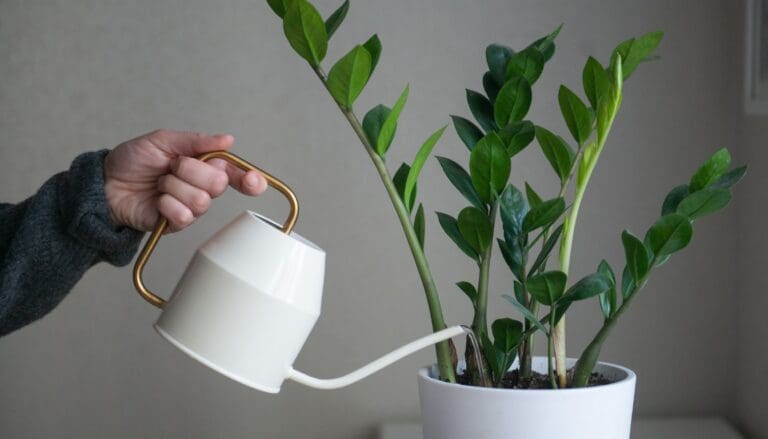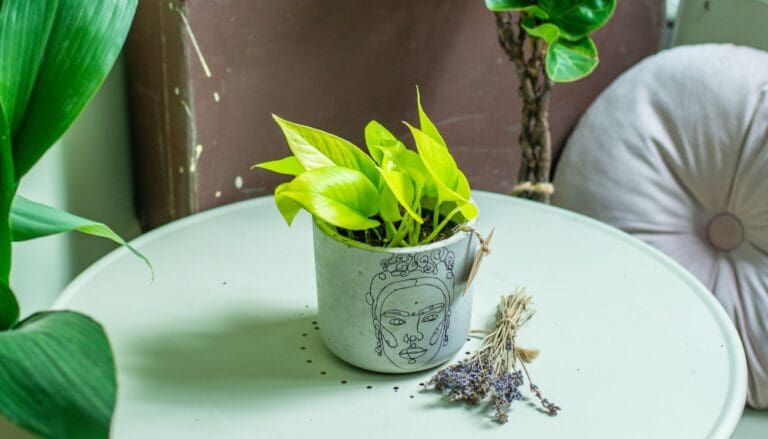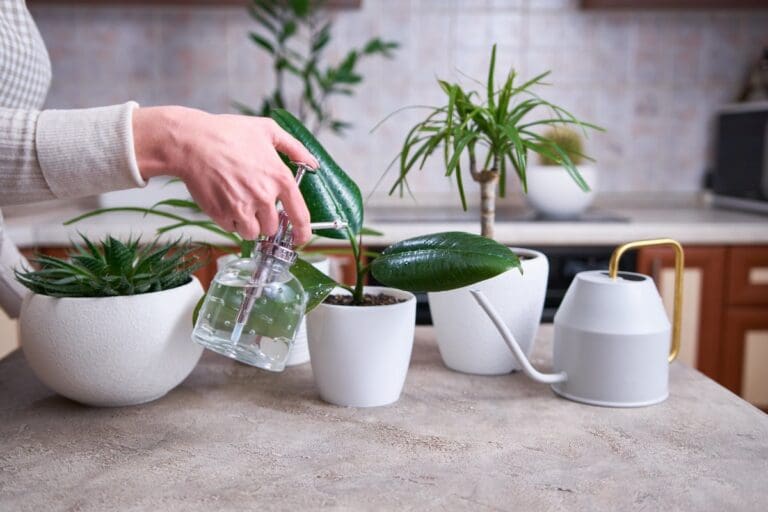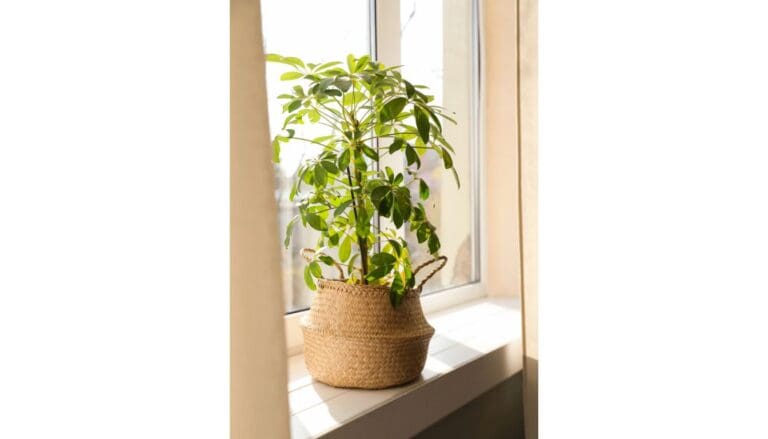Why Is My Arrowhead Plant Drooping? (Causes+How To Fix)
Arrowhead plant or Syngonium is an easy to care houseplant that does not demand too much attention and can be grown easily without any hesitation. But if the leaves of your Arrowhead plant are drooping, then there is a problem.
Overwatering and underwatering are the most typical reasons for the drooping of arrowhead plants. In both cases, the plant cannot absorb enough moisture and nutrients, making it limp. Besides that, low humidity and temperature stress are other probable problems that lead to drooping.
This article will describe the various causes of the drooping of arrowhead leaves, along with some practical strategies for identifying and correcting the problem.

Please note: Simplify Plants is reader-supported. Some links in the post are affiliate links and I get a commission from purchases made through links in the post.
Why is my Arrowhead Plant droopy?
If your arrowhead is droopy, it indicates that the plant is not in good health.
If your Syngonium is not getting proper care or staying in unfavorable conditions, it can get droopy leaves.
If you don’t want your arrowhead plant to go through such problems, you should figure out the problem and try to cure it as fast as possible before the situation gets worse.
Let’s understand all the possible causes in detail and the treatment.
Underwatering

Insufficient water is the most common problem behind droopy leaves.
No houseplant likes to stay in dry conditions and experiences multiple problems due to that.
It is quite easy to forget to water your houseplants, resulting in drooping and wilting foliage.
Due to a lack of water, arrowhead plants fail to get the nutrients and moisture required to live and grow.
Because of this reason, the plant struggles to stay stiff and starts to droop.
Extremely compact soil, crispy foliage, brown tips, and edges are some common signs of underwatering.
How to revive an underwatered arrowhead plant?
Fortunately, your underwatered arrowhead plant should recover once you begin providing adequate water.
- First, examine the soil by poking the finger into it to determine the soil’s moisture. If 50-75% of the soil feels dry, you should immediately water your Syngonium.
- You can also lift the container to feel its weight as dry dirt is considerably lighter than wet soil.
- Keep watering your arrowhead plant until you see extra water coming out from the drainage holes.
- Prepare a proper watering schedule for your arrowhead. Depending on the soil’s moisture level, water your plant 2 to 3 times a week to prevent underwatering.
Also read: How To Water Arrowhead Plant? (How Often+Summer & Winter)
Overwatering

Overwatering is another common reason for droopy arrowhead plants.
Overwatering mostly occurs when you water your plant without checking the soil’s moisture level.
Any factor that causes the soil to become waterlogged for an extended period may result in root rot that causes droopy leaves.
Sometimes we don’t know how much to water our plants, and because of that, we start watering our plants frequently.
Frequent watering creates a damp condition, and the roots fail to breathe, making the plant unhealthy and weak, due to which it droops.
Lower leaves turning yellow and brown, curling of leaves, foul smell from the soil are the common symptoms of overwatered arrowhead plants.
How to revive an overwatered arrowhead plant?
Overwatering is harder to cure compared to underwatering.
To treat overwatering, you have to follow the steps given below:
- As soon as you notice the symptoms of overwatering, stop watering your arrowhead plant immediately.
- To reduce overwatering, add compost to the soil to absorb the excess water.
- Change the location of your arrowhead to a spot where it will receive bright indirect sunlight. But avoid keeping the plant in direct sun.
- If the plant has root rot, take it out of the container and prune off all the infected roots. After pruning, repot the plant in a whole new container using a new potting mix.
- Reduce watering your arrowhead plant during the winter season as the plant stays dormant and requires less water.
Improper light

Arrowhead plant requires bright indirect sunlight to thrive.
You should not expose Syngonium to the direct sun as it can be harmful.
Low light and excessive light can cause droopy leaves on your arrowhead plant.
The arrowhead plant won’t get the necessary energy to survive in low light as it fails to photosynthesize.
Because of this reason, the plant becomes weak and starts to show signs like droopy leaves.
In excessive light, the water in the soil surface will evaporate quickly.
Due to this, the plant will get dehydrated, and the leaves will start to droop.
Discolored and curly leaves are the symptoms of improper light.
How to fix light issues?
You should provide arrowheads with the light that is suitable for them.
To fix the light issues:
- First, place the arrowhead plant where it will get enough bright indirect sunlight.
- The best location is east or north-facing window. This location helps to prevent the plant from getting scorched.
- Avoid keeping the arrowhead plant near a south-facing window. The sunlight might get intense in this location. But if you are keeping the plant near a south-facing window, provide a filter to the plant by using curtains, window films, shutters, etc.
- You can place your Syngonium in a bright location to solve the low light issues. Even if it is not enough, you can provide the plant with artificial light.
Also read: Arrowhead Plant Light Needs: What Type, How Much & More
Low humidity
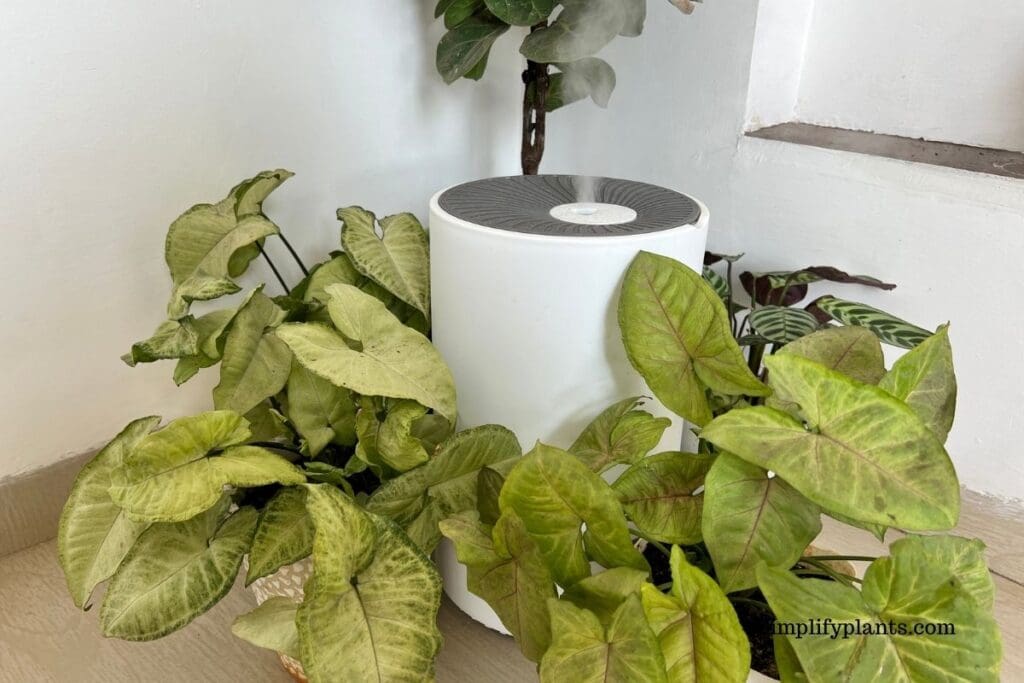
Arrowhead is a tropical plant, so it prefers high humidity.
If this plant fails to receive enough humidity, it becomes difficult for it to survive.
Because of low humidity, the leaves will fail to get moisture from the atmosphere.
Due to lack of moisture, the arrowhead plant can suffer from dehydration that causes droopy leaves on the plant.
Syngonium can droop if the humidity level inside the house goes below 40-50%.
Brown, curly, droopy, and crispy leaves are the common symptoms of low humidity.
The symptoms of low humidity and underwatering are almost the same, so it might become a little difficult to identify the exact problem.
You can use a hygrometer device to check whether the arrowhead plant is getting humidity.
How to fix the low humidity problem?
- Place the arrowhead in an area with high humidity of 50% or more.
- You can mist the plant, but it can boost the humidity levels only for a short while.
- If the humidity is low inside your house, you can use a humidifier. When you feel that the atmosphere is extremely dry for arrowheads, switch on the device and leave for at least 1 to 2 hours.
- You can also keep the plant in a pebble tray. The water evaporates and raises the humidity levels around the plant. Make sure the plant’s base isn’t submerged in water.
- Keeping the arrowhead plant together with other plants can raise 10-15% humidity levels.
- Keep the arrowhead plant away from the heating objects.
Also read: Do Arrowhead Plants Like Humidity? (+Misting?)
Temperature stress
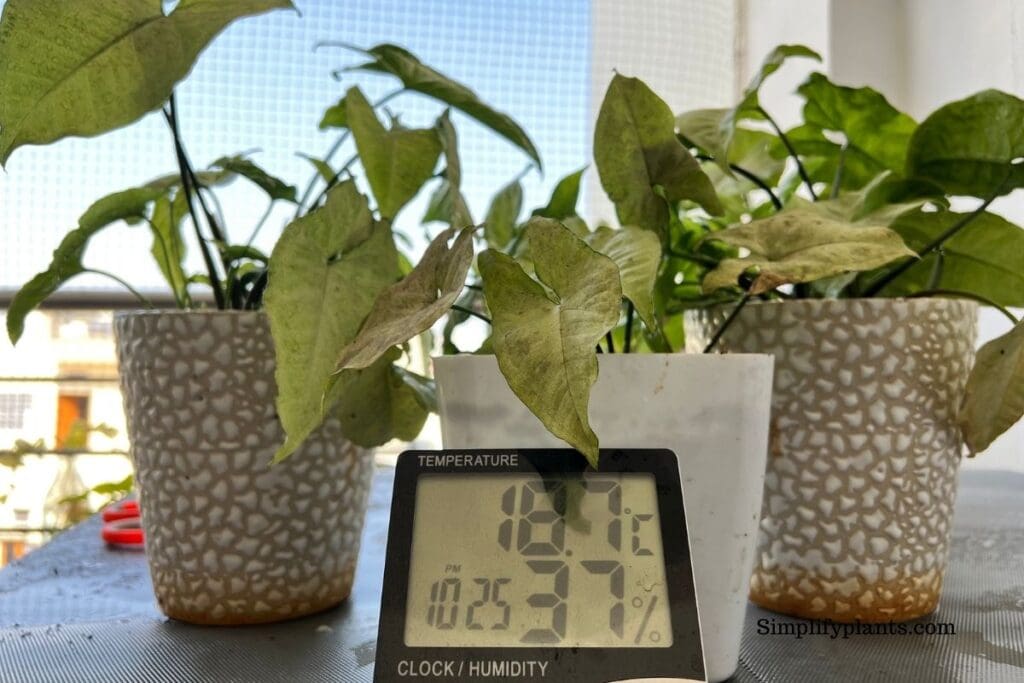
If the temperature goes below 50°F (10°C), it can make the arrowhead plant droop.
The most suitable temperature for the arrowhead plant is 60-85°F (15-29°F).
If the temperature drops below and higher than the preferred temperatures, it can stress your plant.
As arrowhead is a tropical plant, you should maintain warm temperatures around it.
Otherwise, the plant cannot even survive.
Wilted leaves, brown edges, and tips of leaves are the common symptoms of temperature stress.
How to fix the temperature stress?
- You can check the temperature around your Syngonium with a thermometer. This can help you determine whether you need to adjust the temperature.
- Place the arrowhead plant in a location where it will get suitable temperatures. Make sure the location is warm.
- Provide your arrowhead with bright indirect sunlight.
- Try not to keep your arrowhead plant near an open window, especially when there is a cold draft.
- Don’t place your plant near heating objects like radiators, heaters, or air conditioners.
- To avoid sudden temperature fluctuations, keep the plant away from windows or doors frequently opened or closed.
Also read: Can Arrowhead Plants Grow Outside? (Outdoor Care+Bringing Them In)
Inadequate fertilization

Arrowhead plants need well-balanced liquid fertilizer once a month.
If you fertilize your arrowhead plant frequently with strong doses, it can cause droopy leaves.
It happens because frequent fertilizing can injure the roots making the Syngonium pale and weak.
People also make mistakes by fertilizing the arrowhead during the winter months as it is their dormant time.
Underfertilization can also cause droopy leaves as nutrient deficiencies can make the plant weak and discourage the plant’s growth.
What is the correct way to fertilize your arrowhead plant?
- You should fertilize your arrowhead plant once a month during summer and spring.
- You can use a 10:10:10 or 20:20:20 liquid fertilizer for fertilizing your arrowhead plant. First, mix the fertilizer with water and then apply it to the soil every 4 weeks. This can prevent the plant from getting overfertilized.
- Don’t fertilize your arrowhead during the winter months as it remains dormant and doesn’t require fertilization during this time.
To recover your Syngonium from overfertilization, flush the soil by watering it until it comes out from the holes.
If the roots are burnt due to excess fertilizer, remove the injured roots and repot the plant using fresh potting mix.
Try to use rain or distilled water as it does not contain any hard minerals, unlike tap water.
Also read: How Often Should You Fertilize Arrowhead Plant? (Best Fertilizer For Arrowhead)
Rootbound Arrowhead

When the arrowhead plant grows in a compact pot, it can get root-bound.
If there is no space left inside the pot, it becomes difficult for the roots to develop further, and because of this, the roots start coming out of the pot.
Sometimes, keeping the plant rootbound can benefit the plant but to a certain limit.
If the arrowhead plant stays in this condition for too long, it can harm the plant.
When the roots grow too fast, they take up all the space inside the pot and start displacing the soil.
Due to the absence of soil, the plant will no longer get water and nutrients leading to droopy leaves.
Droopy leaves, stunted growth, roots visible outside the soil are the signs of a root-bound Syngonium.
How to save a rootbound Arrowhead plant?
The only way to solve this problem is repotting.
Choose a pot that is one size bigger than the old one.
Before repotting, remove the injured roots and transplant them in a new pot with fresh potting mix.
Provide the plant with the proper care after repotting, so it doesn’t get stressed.
Also read: Do Arrowhead Plants Like To Be Root Bound? (+Signs & When To Repot)
Repotting shock

Repotting your arrowhead plant might cause stress as it is suddenly introduced to a new environment.
While repotting your arrowhead, you have to be careful to prevent the plant from getting stressed.
It is normal to see your arrowhead plant drooping due to repotting as they need time to adjust.
You should try to provide them with their exact growing condition to avoid this problem.
Other than sudden environmental change, your plant can also get stressed because of physical damage while repotting.
The plant fails to absorb moisture and nutrients if the roots get injured, resulting in weakness and droopy leaves.
How to take care of a recently repotted arrowhead plant?
- Provide your arrowhead plant with the proper growing conditions like light, water, humidity, and temperature.
- Be careful while repotting the plant and avoid doing any physical damage.
- Don’t fertilize your arrowhead immediately after repotting, and wait until the plant adjusts completely.
Pests

Various pests suck out the sap from the arrowhead plants.
These pests are spider mites, aphids, mealybugs, and scales.
The constant absorption of the nutrients that the plant needs through the sap from the plant make it weak and unhealthy, which results in droopy leaves.
Spotted, yellow leaves, wilted leaves, black and white spots are the common symptoms of pest infestation in which you can identify whether pests attack your arrowhead plant.
How to save the arrowhead plant from pests?
- Give a good shower to your arrowhead plant to wash off the pests.
- If the pests are tiny, you can use wet cotton balls to remove them.
- Use neem oil by spraying it on the entire plant, especially the damaged area.
- You can also use soapy water and insecticidal soap to eliminate pests.
- After removing the pests, spray pesticides on the entire plant after you are done.
Also read: Bugs On Arrowhead Plant: Common Pests+How To Get Rid Of Them
Final words
Arrowhead plants can droop for a variety of reasons. Some can be fixed easily, while others require more effort. To figure out what is wrong with your arrowhead plant, you should pay attention to their everyday reactions.
To avoid droopy leaves on your arrowhead plant, follow the tips given in this table.
| Factor | Care Tips |
|---|---|
| Light | Provide indirect bright light to your Syngonium. |
| Water | Water it when 50-75% of the soil goes dry and don’t keep the plant thirsty for too long. |
| Fertilization | Fertilize the arrowhead with a diluted balanced fertilizer during the growing season and stop fertilizing in the winter months. |
| Temperature and Humidity | Provide at least 50-60% humidity to your arrowhead plant and maintain temperatures between 60-85°F. |
| Pest infestation | Keep an eye on your Syngonium to identify the pests before it gets too late. |
| Repotting | Avoid keeping the plant rootbound for too long. Take proper care of the plant after repotting to reduce the repotting stress. |
Reference: CABI, Britannica, United States Department of Agriculture, Wikipedia, Children’s Health Queensland Hospital and Health Service, Missouri Botanical Garden.
Recommended Garden Supplies
| Product Image | Our Recommended Gardening Supplies | Check Offers! |
|---|---|---|
Top Top
Top
Top
Top
Top
Top
Top
Top | rePotme Houseplant and Tropical Classic Potting Soil Mix | Check Offer On Amazon |
 Top
Top
Top
Top
Top
Top
Top
Top | Espoma Organic Indoor Plant Food | Check Offer On Amazon |
 Top
Top
Top
Top
Top
Top
Top
Top | GooingTop LED Grow Light 6000K Full Spectrum Clip Plant Growing Lamp | Check Offer On Amazon |
 Top
Top
Top
Top
Top
Top
Top
Top | Soil Moisture Meter | Check Offer On Amazon |
 Top
Top
Top
Top
Top
Top
Top
Top | Govee Hygrometer Thermometer, Bluetooth Enabled! | Check Offer On Amazon |
 Top
Top | LEVOIT Humidifiers for Large Room(Best For Plants) | Check Offer On Amazon |
 Top
Top
Top
Top
Top
Top
Top
Top | Upgraded DIY Automatic Drip Irrigation Kit, 15 Potted Houseplants Support | Check Offer On Amazon |
 Top
Top
Top
Top
Top
Top
Top
Top | Stainless Steel Heavy Duty Gardening Tool Set | Check Offer On Amazon |
 Top
Top
Top
Top
Top
Top
Top
Top | Bonide Insecticidal Soap | Check Offer On Amazon |
 Top
Top
Top
Top
Top
Top
Top
Top | Bonide 32 oz Spray Neem Oil for Organic Gardening | Check Offer On Amazon |
 Top
Top
Top
Top
Top
Top
Top
Top | Garden Safe Fungicide | Check Offer On Amazon |

